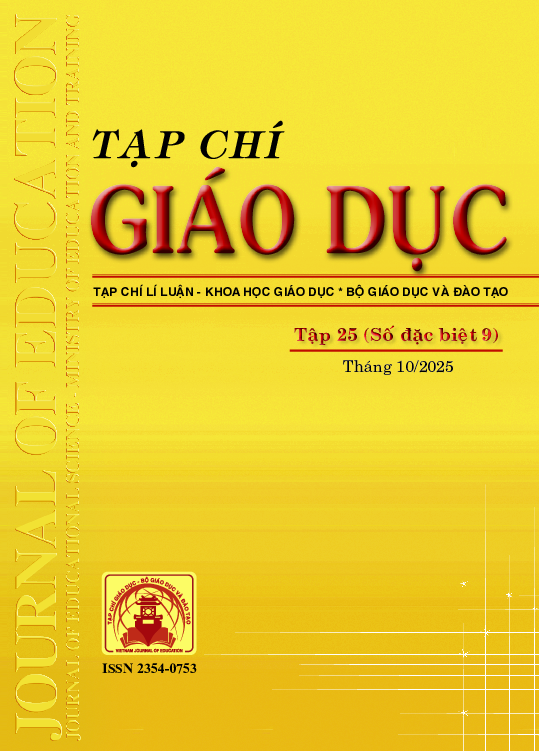Mô hình “lớp học đảo ngược” tích hợp dạy học vi mô, dạy học tình huống và nghiên cứu bài học trên nền tảng số trong phát triển năng lực dạy học: Một nghiên cứu tại Trường Đại học Thủ Dầu Một
Tóm tắt
The requirement to shift from content-based training to competence-based training has posed new challenges for teacher training institutions. This study investigates the design and implementation of a flipped classroom model that integrates microteaching, case-based learning, and lesson study on digital platforms to foster teaching competence in natural and social science education among pre-service primary teachers. Quantitative analysis revealed statistically significant improvements in teaching competence across five core domains: lesson objective formulation, instructional strategy selection, educational technology integration, activity design, and formative assessment. Qualitative data from student reflection journals, peer evaluations, and interviews demonstrated enhanced critical thinking, professional autonomy, and collaborative capacity. The findings affirm the effectiveness of integrating active learning approaches through digital platforms and offer implications for scalable and competence-based innovation in primary teacher education.
Tài liệu tham khảo
Allen, D. W., & Ryan, K. (1969). Microteaching. Reading, MA: Addison-Wesley.
Bates, A. W. (2015). Teaching in a digital age: Guidelines for designing teaching and learning. Tony Bates Associates Ltd.
Bergmann, J., & Sams, A. (2012). Flip your classroom: Reach every student in every class every day. International Society for Technology in Education.
Biggs, J., & Tang, C. (2011). Teaching for quality learning at university (4th ed.). Open University Press.
Darling-Hammond, L. (2006). Powerful teacher education: Lessons from exemplary programs. Jossey-Bass.
Darling-Hammond, L., Flook, L., Cook-Harvey, C., Barron, B., & Osher, D. (2017). Supporting social and emotional development through quality education. Learning Policy Institute.
Fernandez, C., & Yoshida, M. (2004). Lesson study: A Japanese approach to improving mathematics teaching and learning. Lawrence Erlbaum Associates.
Herreid, C. F. (2007). Start with a story: The case study method of teaching college science. Journal of College Science Teaching, 36(6), 62–66.
Mishra, P., & Koehler, M. J. (2006). Technological pedagogical content knowledge: A framework for teacher knowledge. Teachers College Record, 108(6), 1017–1054.
OECD (2020). Initial teacher preparation: Evaluating curriculum design. OECD Publishing. https://doi.org/10.1787/19939019
Thai, N. T. T., De Wever, B., & Valcke, M. (2017). The impact of a flipped classroom design on learning performance in higher education: Looking for the best “blend” of lectures and guiding questions with feedback. Computers & Education, 107, 113–126. https://doi.org/10.1016/j.compedu.2017.01.003
Tran, D. Q. H., & Vo, T. N. T. (2023). The influence of social media literacy on student engagement in online learning. Journal of Computer Assisted Learning, 1–14. https://doi.org/10.1111/jcal.12849
Võ Thị Ngọc Trâm (2024a). Sử dụng công nghệ kĩ thuật số trong triển khai Lớp học đảo ngược nhằm phát triển năng lực dạy học môn Lịch sử và Địa lí cho sinh viên ngành Giáo dục tiểu học: Một nghiên cứu tại Trường Đại học Thủ Dầu Một. Tạp chí Giáo dục, 24(số đặc biệt 11), 30–36.
Võ Thị Ngọc Trâm (2024b). Vận dụng dạy học vi mô để phát triển năng lực dạy học môn Lịch sử và Địa lí cho sinh viên ngành Giáo dục tiểu học. Tạp chí Khoa học Giáo dục Việt Nam, 20(05), 50–56.
Zainuddin, Z., & Halili, S. H. (2016). Flipped classroom research and trends from different fields of study. International Review of Research in Open and Distributed Learning, 17(3), 313–340. https://doi.org/10.19173/irrodl.v17i3.2274
Đã Xuất bản
Cách trích dẫn
Số
Chuyên mục
Giấy phép

Tác phẩm này được cấp phép theo Ghi nhận tác giả của Creative Commons Giấy phép quốc tế 4.0 .












